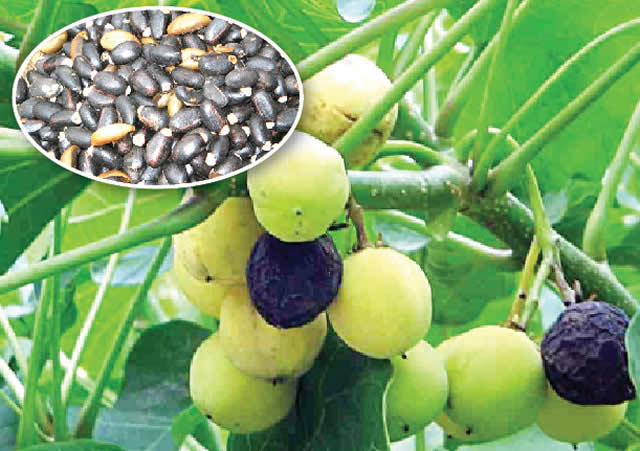Little joy for jatropha growers


The Jatropha plant whose seeds (inset) have been touted as one of the best candidates for biodiesel production
Sifelani Tsiko Senior Writer
As Ms Sophia Chari enters the stage with a group of women singing “Jatropha mutsvairo wekutsvaira nhamo”, seemingly undeterred by the sweltering heat at Nyamuyaruka Business Centre in Mudzi, visitors are thrilled and sing along to show their solidarity with these resilient women from this arid region some 240km east of the capital, Harare.
This tune, when translated, loosely means the multi-purpose jatropha curcas plant, commonly known in this area as “Mujirimono”, is a powerful broom for “sweeping away poverty”.
The jatropha plant, which has been promoted for several years in the area by several NGOs, is seen as an important crop that can end misery for the poor here in Mudzi.
Ms Chari, the chairperson of 17 Environmental Action Groups involved in the growing and processing of jatropha products, and all the women in the area have adopted jatropha growing in good faith with the hope that the non-edible oilseed species can make a difference in their lives.
In a massive planting programme of unprecedented scale millions of marginal farmers and landless people were encouraged to plant jatropha across India through attractive schemes.
They heeded calls to join the massive planting programme to grow jatropha.
They were bombarded with all kinds of messages promoting the growing of jatropha.
The non-edible oilseed species was touted as one of the best candidates for future biodiesel production. Its resistance to drought and pests, and production of seeds containing 27-40 percent oil averaging 35 percent was sweet music to Ms Chari and all smallholder farmers in the area.
The remaining press cake of jatropha seeds after oil extraction could also be considered for energy production.
However, despite the potential of the jatropha species to transform the livelihoods of the poor low seed yields have dampened their hopes.
“We are grateful for the support we are getting from Environment Africa, the World Wide Fund for Nature and all other stakeholders on our jatropha projects,” Ms Chari says.
“We thank you for the jatropha pressing machine you have donated to us. But for us to get true value from your donation we need fertiliser to boost jatropha seed yields. Without fertiliser we will not get anywhere at all.”
Low jatropha seed yields are a nightmare and concern over this is written all over the faces of most women here in Mudzi.
“The machine is going to make processing much easier but the main issue of concern to us are the poor yields. We need support to get fertilisers so that we can boost seed yields,” says Ms Edna Kawiwi of Nyenda village in the Chimukoko area of Mudzi.
Even though, they were particularly excited by the commissioning of the jatropha processing centre at Nyamuyaruka, they were not hesitant to put their message across to the Permanent Secretary for the Ministry of Energy and Power Development, Mr Partson Mbiriri, and the WWF country director Dr Enos Shumba, whose organisation is working closely with Environment Africa to support jatropha growing and processing in the district.
“We want the Government to give us fertiliser so that we can improve jatropha yields and boost out feedstock for our processing plant,” says Ms Chari. “With increased yields we can improve our earnings and we can even go further to supply the country with feedstock for biodiesel production.”
But not all hope has been lost.
The WWF, Environment Africa, the Department of Research and Specialist Services and the University of Zimbabwe have partnered to implement an energy project titled “Biofuels Policies and Practices for Sustainable Socio-Economic Development” to support research and development on the production and utilisation of jatropha as a biofuel feedstock in Mudzi.
“Yields are too low and most farmers are only getting half a tonne to two tonnes per hectare. This is not enough to generate feedstock that can improve their livelihoods and even help to sustain the Mount Hampden biofuels plant which has the capacity to produce some 900 000 litres per year,” says Prof Pa- ramu Mafongoya, a UZ agronomist and jatropha plant research expert.
“We have to raise jatropha plant yields to support feedstock requirements at both community and national level. At least yields of between four to six tonnes per hectare can motivate farmers to plant more jatropha while at the same time striking a balance with food crops.”
He says field trials were being done to determine the yield potential of eight jatropha seed varieties which were collected from eight districts in the country.
“We are doing trials and we are looking at yield potential, disease resistance, pest resistance and oil content,” Prof Mafongoya says. “It’s too early to talk about our findings but one variety we collected here in Mudzi is showing good signs.
“It has produced seed in one year. Normally it takes three to four years for the plant to flower. This is giving us hope and we are still continuing the trials until we find a suitable variety with better yields.”
He says fertiliser is needed to boost jatropha seed yields.
The growing of the non-edible oilseed species of jatropha curcas in lands unsuited to agriculture has been promoted over the years given the high in oil content, early yielding, non-browsable, little irrigation and even less management features of the crop.
And, the commissioning of a jatropha processing machine recently at Nyamuyaruka will benefit more than 17 Environmental Action Groups in Mudzi who extract oil and make soap, candles, lighting fuel, washing powder, floor polish and numerous other products.
The machine has the capacity to process 75kg of jatropha seed per hour.
Mr Kudzanayi Gwande of Environment Africa says farmers can extract 35 litres of oil from 100kg of jatropha seed using the machine.
“Jatropha processing projects can play a crucial role in reducing deforestation in the district,” says Mr Abisai Mafa of the WWF.
“We are supporting smallholder farmers here in Mudzi and Mutoko so that they can realise value from a plant they use as fence.
“The media needs to understand that energy is an enabler for the economy and if people can produce fuels at the local level this can help reduce the country’s huge fuel import bill.”
Mr Gwande says smallholder farmers needed more support to add value to jatropha processing as well as enhancing the quality of products.
However, critics of biofuels charge that use of prime agricultural land for jatropha growing may undermine food security.
And, it seems the future of biofuels production in Zimbabwe lies in how the country will strike a delicate balance between meeting the needs of the “stomach” versus its sharp appetite for renewable energy.
Feedback: [email protected]









Comments